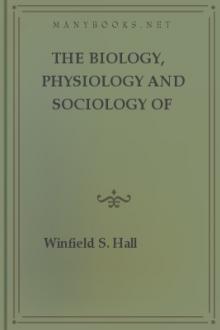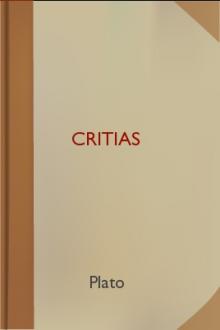Illusions, James Sully [speld decodable readers .TXT] 📗

- Author: James Sully
- Performer: -
Book online «Illusions, James Sully [speld decodable readers .TXT] 📗». Author James Sully
What I am here concerned to show is that the search for consistency and connection in the manifold impressions of the moment is a deeply rooted habit of the mind, and one which is retained in a measure during sleep. When, in this state, our minds are invaded by a motley crowd of unrelated images, there results a disagreeable sense of confusion; and this feeling acts as a motive to the attention to sift out those products of the dream-fancy which may be made to cohere. When once the foundations of a dream-action are laid, new images must to some extent fit in with this; and here there is room for the exercise of a distinct impulse to order the chaotic elements of dream-fancy in certain forms. The perception of any possible relation between one of the crowd of new images ever surging above the level of obscure consciousness, and the old group at once serves to detain it. The concentration of attention on it, in obedience to this impulse to seek for an intelligible order, at once intensifies it and fixes it, incorporating it into the series of dream-pictures.
Here is a dream which appears to illustrate this impulse to seek an intelligible order in the confused and disorderly. After being occupied with correcting the proofs of my volume on Pessimism, I dreamt that my book was handed to me by my publisher, fully illustrated with coloured pictures. The frontispiece represented the fantastic figure of a man gesticulating in front of a ship, from which he appeared to have just stepped. My publisher told me it was meant for Hamlet, and I immediately reflected that this character had been selected as a concrete example of the pessimistic tendency. I may add that, on awaking, I was distinctly aware of having felt puzzled when dreaming, and of having striven to read a meaning into the dream.
The rationale of this dream seems to me to be somewhat as follows. The image of the completed volume represented, of course, a recurring anticipatory image of waking life. The coloured plates were due probably to subjective optical sensations simultaneously excited, which were made to fit in (with or without an effort of voluntary attention) with the image of the book under the form of illustrations. But this stage of coherency did not satisfy the mind, which, still partly confused by the incongruity of coloured plates in a philosophic work, looked for a closer connection. The image of Hamlet was naturally suggested in connection with pessimism. The effort to discover a meaning in the pictures led to the fusion of this image with one of the subjective spectra, and in this way the idea of a Hamlet frontispiece probably arose.
The whole process of dream-construction is clearly illustrated in a curious dream recorded by Professor Wundt.[98] Before the house is a funeral procession: it is the burial of a friend, who has in reality been dead for some time past. The wife of the deceased bids him and an acquaintance who happens to be with him go to the other side of the street and join the procession. After she has gone away, his companion remarks to him, "She only said that because the cholera rages over yonder, and she wants to keep this side of the street to herself." Then comes an attempt to flee from the region of the cholera. Returning to his house, he finds the procession gone, but the street strewn with rich nosegays; and he further observes crowds of men who seem to be funeral attendants, and who, like himself, are hastening to join the procession. These are, oddly enough, dressed in red. When hurrying on, it occurs to him that he has forgotten to take a wreath for the coffin. Then he wakes up with beating of the heart.
The sources of this dream are, according to Wundt, as follows. First of all, he had, on the previous day, met the funeral procession of an acquaintance. Again, he had read of cholera breaking out in a certain town. Once more, he had talked about the particular lady with this friend, who had narrated facts which clearly proved her selfishness. The hastening to flee from the infected neighbourhood and to overtake the procession was prompted by the sensation of heart-beating. Finally, the crowd of red bier-followers, and the profusion of nosegays, owed their origin to subjective visual sensations, the "light-chaos" which often appears in the dark.
Let us now see for a moment how these various elements may have become fused into a connected chain of events. First of all, it is clear that this dream is built up on a foundation of a gloomy tone of feeling, arising, as it would seem, from an irregularity of the heart's action. Secondly, it owes its special structure and its air of a connected sequence of events, to those tendencies, passive and active, to order the chaotic of which I have been speaking. Let us try to trace this out in detail.
To begin with, we may suppose that the image of the procession occupies the dreamer's mind. From quite another source the image of the lady enters consciousness, bringing with it that of her deceased husband and of the friend who has recently been talking about her. These new elements adapt themselves to the scene, partly by the passive mechanism of associative dispositions, and partly, perhaps, by the activity of voluntary selection. Thus, the idea of the lady's husband would naturally recall the fact of his death, and this would fall in with the pre-existing scene under the form of the idea that he is the person who is now being buried. The next step is very interesting. The image of the lady is associated with the idea of selfish motives. This would tend to suggest a variety of actions, but the one which becomes a factor of the dream is that which is specially adapted to the pre-existing representations, namely, of the procession on the further side of the street, and the cholera (which last, like the image of the funeral, is, we may suppose, due to an independent central excitation). That is to say, the request of the lady, and its interpretation, are a resultant of a number of adaptative or assimilative actions, under the sway of a strong desire to connect the disconnected, and a lively activity of attention. Once more, the feeling of oppression of the heart, and the subjective stimulation of the optic nerve, might suggest numberless images besides those of anxious flight and of red-clad men and nosegays; they suggest these, and not others, in this particular case, because of the co-operation of the impulse of consistency, which, setting out with the pre-existing mental images, selects from among many tendencies of reproduction those which happen to chime in with the scene.
The Nature of Dream-Intelligence.
It must not be supposed that this process of welding together the chaotic materials of our dreams is ever carried out with anything like the clear rational purpose of which we are conscious when seeking, in waking life, to comprehend some bewildering spectacle. At best it is a vague longing, and this longing, it may be added, is soon satisfied. There is, indeed, something, almost pathetic in the facility with which the dreamer's mind can be pacified with the least appearance of a connection. Just as a child's importunate "Why?" is often silenced by a ridiculous caricature of an explanation, so the dreamer's intelligence is freed from its distress by the least semblance of a uniting order.
It thus remains true with respect even to our most coherent dreams, that there is a complete suspension, or at least a considerable retardation, of the highest operations of judgment and thought; also a great enfeeblement, to say the least of it, of those sentiments such as the feeling of consistency and the sense of the absurd which are so intimately connected with these higher intellectual operations.
In order to illustrate how oddly our seemingly rational dreams caricature the operations of waking thought, I may, perhaps, be allowed to record two of my own dreams, of which I took careful note at the time.
On the first occasion I went "in my dream" to the "Stores" in August, and found the place empty. A shopman brought me some large fowls. I asked their price, and he answered, "Tenpence a pound." I then asked their weight, so as to get an idea of their total cost, and he replied, "Forty pounds." Not in the least surprised, I proceeded to calculate their cost: 40x10=400÷12=33⅓. But, oddly enough, I took this quotient as pence, just as though I had not already divided by 12, and so made the cost of a fowl to be 2s. 9d., which seemed to me a fair enough price.
In my second dream I was at Cambridge, among a lot of undergraduates. I saw a coach drive up with six horses. Three undergraduates got out of the coach. I asked them why they had so many horses, and they said, "Because of the luggage." I then said, "The luggage is much more than the undergraduates. Can you tell me how to express this in mathematical symbols? This is the way: if x is the weight of an undergraduate, then x + xn represents the weight of an undergraduate and his luggage together." I noticed that this sally was received with evident enjoyment.[99]
We may say, then, that the structure of our dreams, equally with the fact of their completely illusory character, points to the conclusion that during sleep, just as in the moments of illusion in waking life, there is a deterioration of our intellectual life. The highest intellectual activities answering to the least stable nervous connections are impeded, and what of intellect remains corresponds to the most deeply organized connections.
In this way, our dream-life touches that childish condition of the intelligence which marks the decadence of old age and the encroachments of mental disease. The parallelism between dreams and insanity has been pointed out by most writers on the subject. Kant observed that the madman is a dreamer awake, and more recently Wundt has remarked that, when asleep, we "can experience nearly all the phenomena which meet us in lunatic asylums." The grotesqueness of the combinations, the lack of all judgment as to consistency, fitness, and probability, are common characteristics of the short night-dream of the healthy and the long day-dream of the insane.[100]
But one great difference marks off the two domains. When dreaming, we are still sane, and shall soon prove our sanity. After all, the dream of the sleeper is corrected, if not so rapidly as the illusion of the healthy waker. As soon as the familiar stimuli of light and sound set the peripheral sense-organs in activity, and call back the nervous system to its complete round of healthy action, the illusion disappears, and we smile at our alarms and agonies, saying, "Behold, it was a dream!"
On the practical side, the illusions and hallucinations of sleep must be regarded as comparatively harmless. The sleeper, in healthy conditions of sleep, ceases to be an agent, and the illusions which enthral his brain have no evil practical consequences. They may, no doubt, as we shall see in a future chapter, occasionally lead to a subsequent confusion of fiction and reality in waking recollection. But with the exception of this, their worst effect is probably the lingering sense of discomfort which a "nasty dream" sometimes leaves with us, though this may be balanced by the reverberations of happy dream-emotions which sometimes follow us through the day. And however this be, it is plain that any disadvantages thus arising





Comments (0)